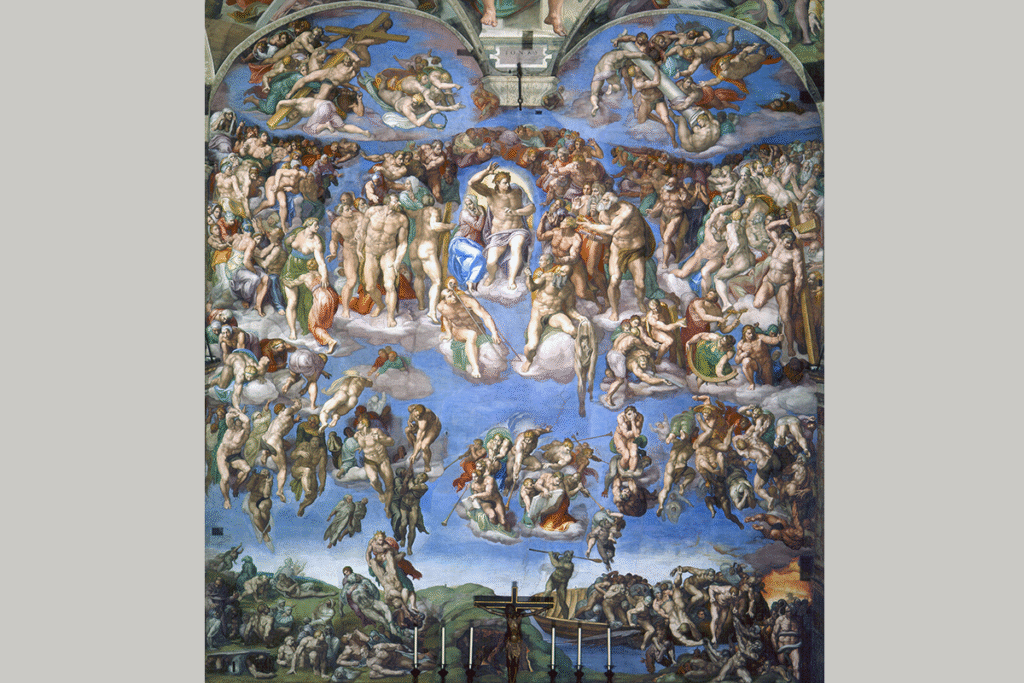 For this comparative essay, I chose Thomas of Celano’s Dies Irae and Michelangelo’s Last Judgment. I shall focus on some stanzas of the Gregorian sequence. Dies Irae is a Latin sequence composed by a member of the Franciscan Order, Thomas of Celano, in the 13th century. This Gregorian chant melody was composed for the Requiem Masses; especially in the liturgical celebration of All Souls’ Day in the Roman Catholic Church.
For this comparative essay, I chose Thomas of Celano’s Dies Irae and Michelangelo’s Last Judgment. I shall focus on some stanzas of the Gregorian sequence. Dies Irae is a Latin sequence composed by a member of the Franciscan Order, Thomas of Celano, in the 13th century. This Gregorian chant melody was composed for the Requiem Masses; especially in the liturgical celebration of All Souls’ Day in the Roman Catholic Church.
The text of the chant is a medieval Latin poem rooted in the richness of the Holy Scripture, mainly in passages with apocalyptic themes, such as: the Book of the Prophet Zephaniah; the gospel according to Matthew and Luke; the first letter of Saint Paul to the Thessalonians; the second letter of Saint Peter, and the Book of Revelations.
When I first heard this Gregorian composition, I was struck by its melancholy and the sense of uncertainty, awe, and fear it evoked in me. Especially at the beginning of the first two stanzas, both the text (Dies iræ, dies illa, solvet sæclum in favilla: teste David cum Sibylla. Quantus tremor est futurus, quando judex est venturus, cuncta stricte discussurus!) and the melody rise my intellect and senses to gaze at the glory of God. I admire and imagine Jesus’ second coming and the Resurrection of the dead.
The Latin Sequence has several melodies. Nevertheless, these are simple and repetitive, ensuring whoever hears them can focus on the text in lieu of being distracted by the melody. Going forward through the stanzas, the text invites me to listen carefully and invites me to participate, in a certain and speculative way, in the Last Judgment. I do see a shift of sentiment in a particular way in stanzas eight, nine, and ten, where my soul seems to be yelling for pity, pardon, and mercy to the King of tremendous majesty, making Him remember that I am a cause of His Incarnation, Passion and Death on the cross, and His glorious Resurrection. Again, the melody in stanza number eight is simple, with its pulse, rather than rhythm, evoking uncertainty once more. In stanzas eight and nine, the melody suffers a change to emphasize the appeal of the soul before the Eternal Judge, with arsis and thesis in the new melody; something proper to Gregorian chant.
The Latin Sequence returns to the same melody as the beginning in stanzas thirteen and fourteen, where souls appeal to the mercy of the Eternal Judge through some Holy Scripture instances, such as the thief on the cross who begged for pardon or the adulterous woman. Actually, some texts say that this woman was Mary Magdalene; however, other texts only mention pecatricem. Finally, in the last stanza, the composer breaks with the alternation of musical patterns in the melody; as if returning the listener’s soul to reality. This is to emphasize that supplication for the faithful departed, and both the change of melody and the text help achieve this purpose; also something quite typical of Gregorian chant.
I want to compare this Gregorian sequence with the Last Judgment, a 1536 – 1541 fresco by the Renaissance artist Michelangelo Buonarotti. This iconic fresco depicts the Second Coming of Christ and God’s final and eternal judgment of all humanity. The artwork deals with the same themes as Celano’s Dies Irae. Fear, uncertainty, melancholy, and all of these tremendous emotions are also presented in this fresco.
It is as if each stanza of Dies Irae fits perfectly into each of the elements seen in this work by Michelangelo. From the trumpets and the resurrection of the dead to the fear on the faces of the damned and the majestic glory of Jesus. Each character provokes a different feeling according to their fate in Michelangelo’s Final Judgment. When I contemplate the fresco, the same feelings arise in my soul as when I listen to the Dies Irae: there is admiration before the Omnipotence of Jesus, who comes to judge. Moreover, now that the expected day has arrived, the heavens are open, and the whole of creation reacts to the triumph of Christ; however, each part reacts in a different way.
Nevertheless, I shall focus my attention on one figure: the damned soul alone. This man’s expression is despair, anguish, and desolation. In the fresco, this figure is represented as a damned soul who is separated from the chosen ones who ascend towards Heaven. The facial expression and body gestures convey a sense of torment and hopelessness, symbolizing the eternal suffering of those who are condemned in Michelangelo’s Final Judgment, a quite good reminder that humanity must be prepared for that meeting with the King of tremendous majesty.
However, both Michelangelo’s Last Judgment and Celano’s Dies Irae are simple and solemn reminders that evoke similar themes and feelings, that is to say, that one-day human beings will die and will be judged for their actions. The melody of the Latin Sequence is haunting, and each stanza has its own visual expression in the details of the Last Judgment. Whether a monotonous, monophonic, solemn melody and slow rhythm or pulse of Celano’s composition, whether the realistic and talented Michelangelo’s artwork, the purpose is still the same: be aware that we will die and be judged before the just and merciful Judge.
Bibliography
- Leionariorum Christi Congregatio, R. Bradbury, Liber Cantus Gregoriani, Legionaries of Christ Inc., Rome, Italy 2001, pp. 626 – 629.
- M. Bounarotti, Giudizio Universale, Fresco, Sistine Chapel, Vatican City, Renaissance 1550.
- -, Detail of the Giudizio Universale: the damned soul alone, Fresco, Sistine Chapel, Vatican City, Renaissance 1550.



